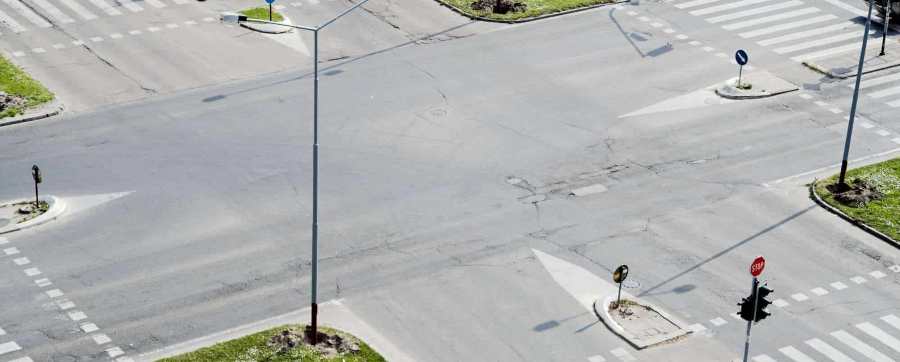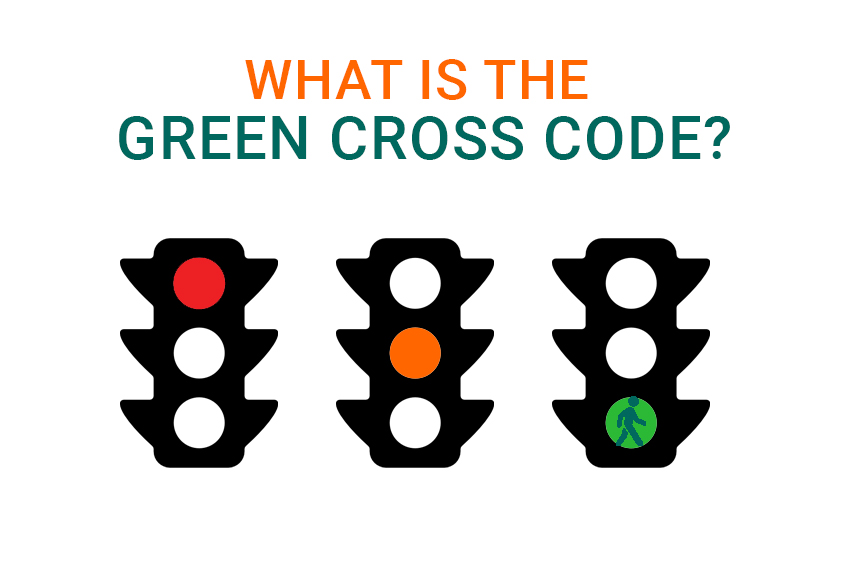The Green Cross Code is probably one of the most well-known codes in the UK. In 1970, the National Road Safety Committee, now known as ROSPA, or the Royal Society for the Prevention of Accidents, set up the Green Cross Code. The intention of the code was to raise awareness of pedestrian road safety in the UK.
So, the campaign has been around for quite a few years now and is still as important now as it was when it was first established.
But, what exactly is the Green Cross Code?
In this article, we look at the history of the Green Cross Code, what it is, and top safety tips that can be learnt by following the rules it sets out.

The history of the Green Cross Code
As we’ve already mentioned, the Green Cross Code was launched in 1970. It replaced the Kerb Drill, which was a pedestrian safety campaign with military-style “Halt! Quick march!” instructions.
However, it was felt that the Kerb Drill was too confusing for children so it was replaced by the Green Cross Code campaign.
The Green Cross Code is a step-by-step procedure that helps pedestrians cross the road safely.
Over the years, the Green Cross Code has changed slightly, but the concept remains the same. To promote it, they created a superhero called the Green Cross Code Man. It was felt that by creating someone like Superman they would be able to appeal to young children and they would pay attention to what he taught them.
A series of Public Information Films were released, starring David Prowse MBE, who later went on to play Darth Vader in Star Wars. These films ran for 15 years, from 1975 to 1990.
The Green Cross Code man had several superpowers, the most important was the ability to teleport from Green Cross Control to any location where children needed instructions in order to cross the road safely.
Sometimes he was accompanied by a small robot.
As anyone knows, all superheros need a catchphrase, and Green Cross Code Man’s was “I won’t be there when you cross the road, So always use the Green Cross Code”.
In 2014, the Green Cross Code Man was revived for Road Safety Week, and David Prowse returned to the role he had made pretty famous during his time in the uniform.
This time the message he was spreading was just a little different. He was teaching adults about the danger of using smartphone and wearing headphones to listen to music while trying to cross the road.
This could have been a nostalgia-driven choice given the fact that many of these adults would have been children when the original campaign ran. David Prowse wasn’t the only person who spent time being a superhero to children needing safety instructions on busy roads. During the 15 years it ran on billboards and television, other stars also participated in the campaign, including Kevin Keegan, Alvin Stardust, Jon Pertwee (Wurzel Gummidge and Dr Who), Joe Bugner and Les Gray (from the group MUD).
Have you been looking for a new vehicle, but just not sure what special offers are out there? Sign up for our weekly newsletter and we’ll send you the best vehicle offers, right to your inbox.
Newsletter Signup
What is the Green Cross Code?
As we have already mentioned, the Green Cross Code was created in 1970 to establish a set of safety rules for people to follow to ensure they crossed the road safely. The rules are separated into six different stages, which we have listed below.
Think
Find the safest place to cross.
Is it safe to cross where you’re currently standing or is there anywhere safer nearby?
Safer places to cross include:
- A subway or underpass
- Footbridge
- Zebra Crossing
- Traffic island
- Pelican crossing
- Controlled crossing point – such as with a school crossing guard/lollypop person
You should NEVER cross between parked cars, close to the brow of a hill or on a blind bend.
Stop
Stop just before you get to the kerb. Stand on the pavement near the kerb and make sure that you can see the traffic. Don’t step on the road.
Look
Look around for traffic. Listen carefully to approaching traffic that you cannot yet see.
Look both right, then left, then right again before you cross the road. If you’re on a one-way street make sure you look out for bus or cycle lanes that may be going in the opposite direction.
Always make sure to look out for bicycles and electric vehicles since both are much quieter and it’s possible you may miss them.

Wait
If traffic is coming, then let it pass. If you’re waiting at a crossing then wait until the cars have stopped. If you’re not already on the crossing then cars are not obliged to stop for you. If you’re at a Pelican Crossing then wait until the green man is showing on the traffic light before you start to cross the road.
If you’re not at a crossing, then wait until it is safe to cross. Once the traffic has passed, look around again and listen.
If you are crossing when there is traffic, keep an eye out for cyclists passing the traffic.
Look and listen again
When it’s safe and there is no traffic, you can walk straight across the road. It’s important to remember that you should not walk across the road diagonally. The shortest and quickest journey from one side of the road to the other is a straight line!
Continue to look and listen for traffic as you’re crossing the road and, most importantly, NEVER run.
Arrive alive
This is pretty straightforward. Keep looking and listening while you are crossing the road.
If you are crossing when there is traffic, keep an eye out for cyclists that are going through the traffic. Often they will not see you and you will not hear them.
What is SPLINK?
In a Public Information Film made in 1976, starring John Pertwee, a mnemonic was introduced to make the Green Cross Code even easier to remember. That mnemonic was SPLINK.
Looking for a new vehicle? Call us now on 01903 538835 or request a callback and we can help.
How to teach your child the Green Cross Code
As the Green Cross Code Man said, he won’t be there when you cross the road. But you will be there when your children are young.
There are some ways you can teach your child the Green Cross Code.
Lead by example
When you’re out and about with your child(ren), make sure that you always follow the rules yourself. It’s really easy to forget and you can quickly fall back into bad habits when you’re in a hurry (with or without children).
When you’re with them and need to cross the road, follow these few simple steps to instil road safety rules in their minds:
- Tell them what you’re doing
- Tell them why you’re choosing a certain place to cross
- Let them know why you’re waiting
- Make a point of telling them how many times you’re looking left and right before crossing
- Tell them why it’s safe to cross the road – when you’re crossing

The more you do this, the more they will consider it the norm and, when the time comes for them to cross the road alone, they will follow the Green Cross Code exactly as you taught them to.
Make sure that others are following the Green Cross Code
If your child is looked after by a babysitter, an older sibling or another family member, then make sure that they are also following the Green Cross Code.
This is especially important if your child looks up to whoever is taking care of them. They are more likely to copy someone they admire and if this person has bad road safety habits then this could be disastrous.
Ask them to help you cross the road
After you’ve been practising the Green Cross Code with your child(ren), a great way to find out what they have remembered and also show them that you trust them is to ask them to help you get across the road safely when you’re out and about.
Ask them why they’re making the decisions they have and also ask when they feel it’s safe to cross.
Do this as many times as you can, until they are old enough to cross the road alone.
When the time comes for them to cross the road (whether on the way to school or a friend’s house) you will be reassured that they have had enough practice and are aware of the rules of crossing the road safely. Though the campaign of the 1970s is now more remembered because of the costumes, it’s safe to say that it was successful in making children (and adults) more aware of road safety.
Children of the 2000s and 2010s onwards will likely be more familiar with the campaign set to The Proclaimer’s song “King of the Road” starring two cartoon hedgehogs, but the message remains the same.
Stop, Look, Listen!

